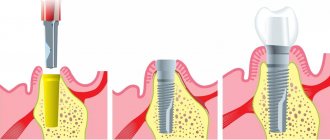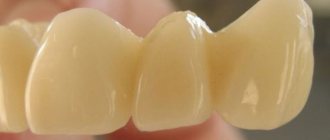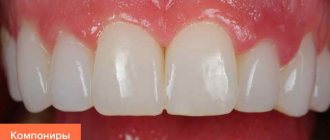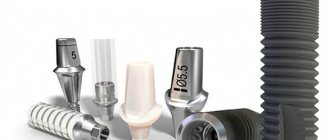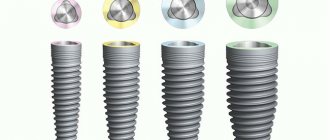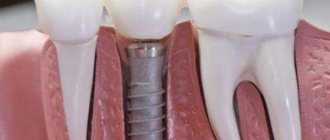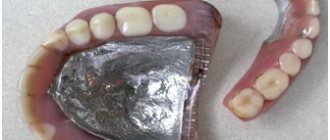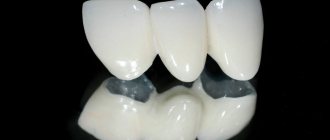Extension of chewing teeth
Chewing teeth are also often subject to destruction, in most cases the cause is caries. After treatment of caries, especially deep ones, large cavities remain, which the specialist fills with filling material after treatment. However, in some cases, only the root and a few thin walls may remain from the tooth, and sometimes even these remain. However, one of the trends in modern dentistry is the use of maximally tooth-preserving techniques. Therefore, if previously a healthy root that had lost its coronal part would most likely have been removed and a bridge-like prosthesis installed instead of the tooth, or, at best, an implant, today they prefer to preserve the root and restore the coronal part by installing an inlay and a crown.
Tooth extension onto a pin
Some dentists still carry out tooth augmentation on a pin, which involves installing a metal rod (pin) directly into the root canal and layer-by-layer application of composite materials on it. Once upon a time, this method was a real breakthrough compared to conventional filling, as it made it possible to preserve the root and completely restore the tooth, even in cases where the coronal part was completely lost. However, subsequently, caries often formed around the pin, which provoked further tooth destruction and loss. Therefore, pins are a thing of the past, giving way to more reliable methods.
What is dangerous about malocclusion?
Violations of occlusion entail diverse consequences from gastrointestinal disorders to psychological complexes. If you are already thinking about correcting your bite, you are most likely familiar with its consequences firsthand. It is also worth noting that malocclusion often provokes premature tooth decay, as it is often the cause of pathological abrasion of teeth, the development of caries and periodontitis. In addition, the pathology can lead to overload of the temporomandibular joint, when the patient replaces clicks and crunches when opening and closing the mouth.
Correction with crowns
The installation of crowns as tooth extensions is also used in cases where the tooth is not destroyed, but is sufficiently damaged. Installing a crown is one of the effective ways to restore a broken tooth, this applies to both front and chewing teeth. Crowns are also used in cases where it is not possible to fill a chewing tooth, for example, because the cavity left after caries treatment is too large. This type of permanent prosthetics, such as crowns, is an ideal solution in cases where more than 70% of the crown part of the tooth is missing.
In modern aesthetic dentistry, ceramic and metal-ceramic crowns are successfully used. The installation process itself takes place in two stages. First, the doctor prepares the tooth (removes infected tissue, grinds down the walls), then an impression is taken, from which a crown for a chewing tooth or a crown for a front tooth is made in a dental laboratory. The second stage is the fitting and installation of the finished crown. Modern ceramics, used for the manufacture of inlays and crowns, make it possible to perfectly imitate the texture, color and transparency of natural enamel, as well as select a shade in accordance with the color of neighboring teeth.
At what age should correction begin?
Orthodontic correction can begin at the age of 6-8 years, but at this time only removable appliances such as plates are used. Braces can be installed only after all permanent teeth have erupted. This process is usually completed by age 14. Today, you can also correct your bite using clear aligners. They are used from 16-18 years of age. It is important here that the teenager understands the importance of treatment and is motivated to complete it, aware of the importance of what is happening. Since the aligners are easy to remove, parents need to be sure that the child is actually wearing them for the required amount of time. Otherwise, it will be impossible to achieve a positive result.
Correcting overbite with braces in adults
Many people are concerned about the question: can teeth straighten themselves? As already mentioned, the process of jaw transformation ends at the age of 14 years. Teeth can also shift when third molars (wisdom teeth) erupt, which usually occurs between the ages of 18 and 25. However, in such a situation one cannot expect positive changes. In the future, the position of the teeth does not change.
For such serious disorders as progenia, prognathia, and significant crowding of teeth, treatment with a permanent brace system is indicated. Today, patients have the opportunity to choose a system made of metal, synthetic sapphire, and ceramics. The products are characterized by high aesthetics, are suitable for long-term treatment and allow you to achieve expressive aesthetic results.
How to straighten your front teeth
Aligners are best suited for straightening frontal teeth. They allow for easy rotation, extrusion, intrusion and tooth movement. They can also help eliminate crowding. To do this, teeth are separated - a small amount of enamel is removed in the proximal area (between the teeth). Due to the freed up space, the teeth are moved. Separation is a safe and painless procedure. Activators help speed up the alignment process - small composite “dots” that the doctor forms on the surface of the teeth. They serve as additional support for the system, but at the same time do not interfere with the aesthetics of the smile.
Indications and contraindications
Depending on the chosen method of teeth extension, indications and contraindications for each specific technique should be determined by your dentist. In this situation, you should not be guided solely by your taste preferences. Otherwise, your uncompromising demand: “I want veneers!” may lead to the fact that the treatment will not bring the desired effect, and the money will be wasted. Don't forget: everything is individual. For example, extensions using photopolymers are not practiced if there is severe tooth mobility. It is also recommended to avoid veneering for those patients who suffer from periodontal disease or do not have the necessary dental hygiene skills.
Main indications for extensions
- Cracks and chips
Microdamages caused by trauma. - Damage to the crown
If the dental crown is deformed or broken. - Consequences of caries
In case of advanced caries, when the tooth root is intact, but the area for filling is too large. - Gaps between teeth
Diastema, which negatively affects aesthetics. - Changing the color of the enamel A
dental defect such as fluorosis - white spots on the surface of the tooth enamel - cannot be eliminated with whitening, but can be corrected with extensions. - Increased tooth abrasion
As a result of demineralization of tooth enamel or a hereditary factor. - Malocclusion
Effective for mild defects in the occlusion of the dentition.
Absolute contraindications to extensions
- Maximum damage to the tooth
If the tooth is destroyed by more than 30%, the extension will not give a positive result. - Allergy
An allergic reaction to individual components of filling materials is rare, but its presence makes extension impossible. - Bruxism
Night and daytime teeth grinding will definitely lead to the destruction of the extended tooth. - Unsuccessful tooth localization
If the tooth is located in such a way that it cannot be isolated from saliva during the procedure, which neutralizes its result.
Indications for tooth root or crown removal
With periodontitis, a tooth can still be saved if it is not completely destroyed. In other cases, there is a threat of infection of the entire body, a bag of pus hangs at the top of the root, a granuloma or cyst is formed, waiting for an opportune moment for the formation of flux, so the source of inflammation must be eliminated surgically.
Affected teeth are urgently removed in case of jaw injuries, in particular if they are located in the area of bone fracture. They are removed first, before applying the splint. In case of complex fractures of the tooth itself (for example, longitudinal), when restoration is impossible.
Sometimes there was a huge filling on a dead tooth for a long time. When it finally falls out, the thin walls quickly collapse, leaving a stump with sharp edges.
Filling fell out of tooth
If an individual dental unit is broken (the tooth wall is damaged to its full depth, below the gum level, individual fragments are unstable), the bone tissue is removed completely or partially, only the moving parts, replacing them with a prosthesis. If you bring a tooth to the dentist that has just been knocked out, he can perform a replantation and return it to the socket. Such operations are rare, but true.
The dentist will recommend urgent removal for marginal periodontitis - severe tooth mobility. If it is simply unstable due to injury or illness, if the root has mobility of the third degree, a planned operation will be scheduled, choosing a time when the problem does not cause acute pain.
Picture of different forms of periodontitis
Wisdom teeth are often removed because they grow unsuccessfully, which leads to deformation of the entire dentition. Often its sharp edges injure the gums, creating the preconditions for malignant neoplasms. Hygienic care of the outer eights is difficult. If there are no particular problems, there is no need to remove wisdom teeth - this is not the easiest operation, and they can even be useful for prosthetics.
Wisdom tooth removal
If there is gumboil, the gums must also be treated first. Firstly, it is unlikely that such a tooth can be removed painlessly; secondly, a purulent sac through an open wound can infect the entire oral cavity.
In the same planned manner, they get rid of dental debris if the crown is already completely destroyed. When bone tissue is affected by a chronic infectious disease that cannot be eliminated by therapeutic methods, the dentist-therapist sends the patient to a surgeon. Sometimes teeth with poor canal patency or perforated roots cannot be treated. Indications for a visit to the surgeon will include the following problems:
- curvature of the dentition, causing injury to the oral mucosa;
Curvature of the dentition
Anomalies of dental development
Phlegmon of the retromaxillary region
Fortunately, even if the top is destroyed by caries, it is not necessary to remove the stump: the roots can also be treated, then restored with light-curing materials or the upper part can be prosthetized using inlays, crowns or pins. The recommendations do not apply to completely rotten teeth, since this breeding ground for infection guarantees not only bad breath. Against the background of the fight against such inflammations in the mouth, immunity will be constantly reduced; it is not surprising that with bad teeth, the general state of health leaves much to be desired.
Video: Reasons and indications for tooth extraction
How much does tooth augmentation cost?
If we mean tooth extension in the smile zone, then the cost of restoration with composite materials will range from 2,500 rubles to 15,000 rubles per tooth in economy and premium class clinics, respectively. The price of installing ceramic veneers starts from 20,000 per tooth in economic dentistry, and in a VIP clinic the price can reach up to 50,000 rubles per plate. The price for extension of chewing teeth consists of the cost of an inlay, a dental crown on it and the work of an orthopedic dentist, which will cost on average from 10,000 rubles to 50,000 rubles, depending on the materials used and the price segment of the clinic.
